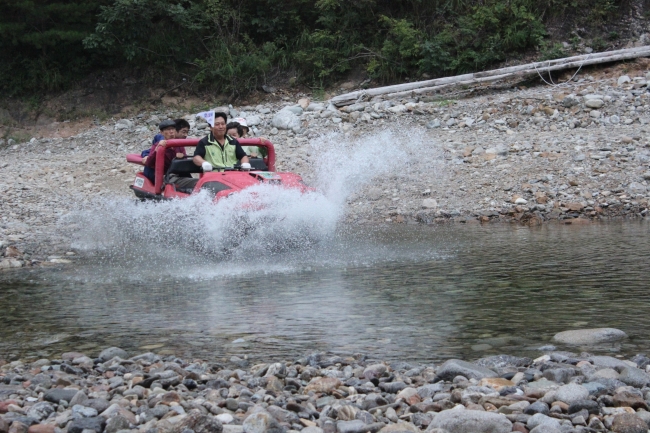Yangyang, Gangwon Province ― Son Tae-yeong used to play among the tall stalks of rice and patchy barren fields of Yangyang County’s Haedam Village in Gangwon Province when he was an elementary schoolboy.
Son’s boyhood job was to collect animal dung for fertilizer in an open clearing where cattle grazed. The 51-year-old farmer recalled how he also had plenty of time for horsing around, too, and rattled off names of games that every Korean of a certain age ― whether raised in the city or the countryside ― could recognize: jaekichagi; biseokchigi, a land conquest game; marbles; and a stick striking game called jatchigi.
“I remember my childhood as golden years and I would not trade my childhood experiences in Haedam for all the money in the world,” Son said. “I love my village.”
It was the late 1960s and early ’70s. Decades later, the same field where Son used to collect cow patties for his father is now a resort-style rural experience center.
Nowadays, fathers can drive with their families just two hours out of Seoul to Haedam, rent small cabins complete with kitchenettes, and swim in a dammed up portion of a creek that meanders beside the village.
Since 2008, Haedam Village’s rural experience camp has been offering visitors on two-day, one-night trips a menu of camp options, such as rafting, kayaking and forest trekking.
Nowadays, Son takes visitors for rides on an eight-wheeled amphibious vehicle through a cordoned-off portion of the creek and along a rugged off-road trail.
Haedam’s rural experience camp is one of 20 similar tourist destinations developed by the Ministry of Food, Agriculture, Forestry and Fisheries to promote rural villages across the country as a unique travel option.
Dubbed the Rural 20 Project, the government categorizes each rural experience camp into one of four broad themes: experience, nature, traditional culture and well-being.
Since 2010, the ministry’s Rural Community Corporation has thinned the 1,800 existing farm tour camps dotted all over the country down to about 80, and then selected from those the ones that best represent national characteristics: Korea’s traditional customs and traditions for the experience tours; the country’s magnificent natural resources and landscapes (nature); its long and ancient history (traditional culture); and the healthy food of the Korean countryside (well-being).
Two kinds of tour programs for each camp site were developed by officials and travel experts, a one-day visit and a longer two-day, one-night visit, provided that the traveler departs from Seoul. For some areas, however, other cities were selected as better departure points for one day courses. All Rural 20 camp sites guarantee visitors a taste of rural Korea, organizers said.
Owning to the wealth of outdoor activities on offer at Son’s hometown, such as trekking up the nearby Jujeon Valley to the impressive Yongsopokpo Waterfall, it is no wonder Haedam was categorized as a “nature” experience.
 |
Son Tae-yeong takes visitors on a ride in an amphibious ATV through a creek at Haedam Village’s rural experience camp in Yangyang County, Gangwon Province, on Sept. 5. (Mode Tour) |
Aside from the rafting, kayaking and Son’s raucous amphibious ATV rides, a key charm of Haedam is its densely wooded environs, which allow for verdant forest walks.
For those interested in experiencing traditional culture, then there is no need to travel farther than Sumi Village in Yangpyeong County. The small Gyeonggi Province village of about 5,000 straddles a wide, shallow river along a band of low, rolling hills.
Sumi Village offers visitors a host of year-round rural experiences: Smelt fishing in winter; strawberry picking in spring; and swimming and other fun sports in the summer.
In fact, Yangpyeong County has garnered some acclaim for its springtime strawberry festival.
But the crisp autumn air and mild temperatures provides ample opportunity for traditional Korean rural experiences, too.
 |
Visitors dig up sweet potatoes at Yangpyeong County’s Sumi Village in Gyeonggi Province on Sept. 5. (Mode Tour) |
Sumi Village has sweet potato harvesting for visitors, and the tall columns of blossoming chestnut trees blanketing the hills promised an authentic traditional experience for guests in October.
November is when Sumi can play its rural experience trump card. That is when, in every corner of the country, Korea’s signature side dish is traditionally prepared.
It is in November when Sumi Village elders conduct classes in how to make delicious kimchi, that fermented, savory food so integral to the Korean diet.
The Rural 20 Project is an ongoing program in which one rural experience camp from one county is highlighted. The camps and counties that are highlighted are updated annually.
For information about reservations to any of the Rural 20 camp sites, contact Mode Tour at (02) 3788-4845. For general information about Sumi, Haedam and Uiyaji villages and the Rural 20 Project, visit the Rural 20 website at www.rural20.kr, which has information in English, Japanese and Chinese.
By Philip Iglauer (
ephilip2011@heraldcorp.com)






![[Exclusive] Hyundai Mobis eyes closer ties with BYD](http://res.heraldm.com/phpwas/restmb_idxmake.php?idx=644&simg=/content/image/2024/11/25/20241125050044_0.jpg)
![[Herald Review] 'Gangnam B-Side' combines social realism with masterful suspense, performance](http://res.heraldm.com/phpwas/restmb_idxmake.php?idx=644&simg=/content/image/2024/11/25/20241125050072_0.jpg)

